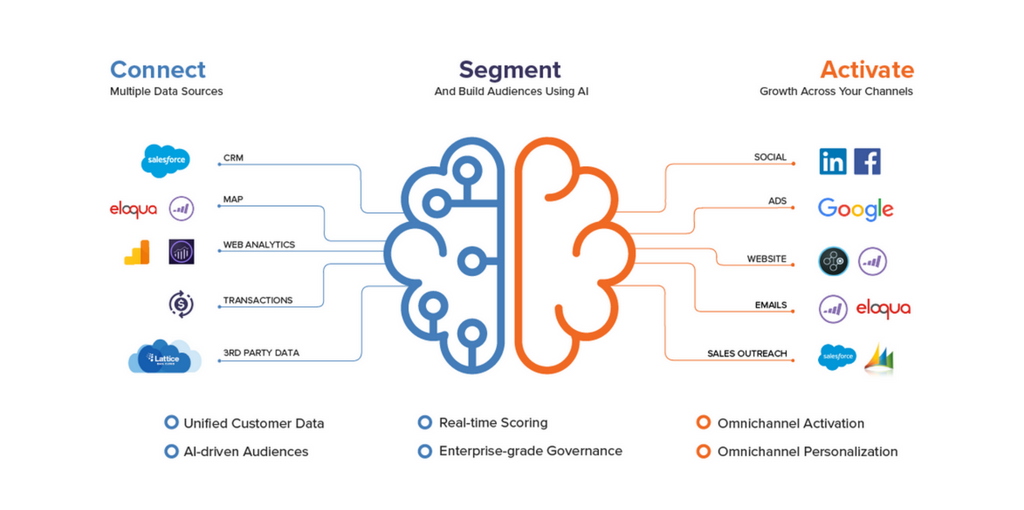How to Maximize the Value of Your Customer Data Platform
August 20, 2018A customer data platform (CDP) is a powerful way to gain visibility into the customer’s path to purchase. Like any robust technology, however, you can’t just turn it on and expect results. Rather, a CDP presents an opportunity to improve processes, such as the way you handle customer data, which you must do if you’re to gain the most value from the solution. In addition, because a customer data platform is an enterprise solution, it also helps you bolster cross-team collaboration to provide a better enterprise-wide customer experience.
Brands who deploy a customer data platform will be able to:
- Create an always-on, always-updating golden record that is continually available at low latency to all touchpoints and to all users across an enterprise to access when they need it;
- Bring together data from across the organization to know all that is knowable about your customers, allowing you to build progressive profiles and create privacy-compliant unified customer records; and,
- Recognize individual customers across multiple channels and interaction touchpoints, so you can deliver relevant, personalized offers whether customers are in your physical location, online, or on their mobile device.
Once you implement a customer data platform, there are five steps you can take to fully leverage its power:
- Build the single customer view
- Add data to enhance each customer’s profile
- Add in-line analytics and machine learning
- Personalize experiences across channels
- Optimize the CDP’s use across the enterprise
Let’s take a closer look at each.
Build the single customer view: You likely have purpose-built silos of customer data that serve specific areas of the business, such as accounting and marketing. These will need to stay in place, and that’s fine, of course. But you must unify the data from those siloed data sources in the CDP to get a complete picture of the customer. Doing so is the only way to provide truly personalized experiences.
To streamline building a single customer view, your customer data platform should be data agnostic and support all data sources: batch or streaming, internal or external, structured or unstructured, transactional or demographic. Advanced CDPs also allow you to integrate first-, second-, and third-party data and function equally well with Hadoop, NoSQL, and traditional data warehouse technologies. Develop a detailed project plan to prioritize how you’ll start connecting these data sources to your CDP and you’ll see that single view of the customer come to life.
Add data to enhance each customer’s profile: One of the most powerful aspects of a customer data platform is the ability to build and maintain a golden customer record at the speed of the consumer. The golden customer record should include every touchpoint or proxy identity the consumer presents, such as a cookie, a social media handle, or even a smartwatch. Each customer’s golden record should also include transactional and behavioral data, as well as other triggers. The transactional data should include the history of all transactions and interactions that a person represented by a proxy identity has had with the brand. And the behavioral and transactional data should integrate into the golden record in real time to ensure that analytics, personalization, and engagement are relevant and up to date.
Add in-line analytics and machine learning: Build a plan to take advantage of the advanced analytics, data processing, and matching algorithms a customer data platform enables. Take a crawl, walk, run approach. For example, start with features such as name, address, and phone standardization. Next, use the CDP to perform deterministic and probabilistic identity resolution and to build customizable groupings such as individual, household, segment, and business. Then add advanced parsing, normalization, and validation rules. After that test geocoding and spatial analysis. Using your CDP to do this intelligent data cleansing will reap huge benefits in analytics, both by reducing the time data scientists and marketing analysts must spend cleaning up bad data – currently data scientists spend more than half of their time cleaning data – and by improving both data quality and timeliness to produce better customer engagement. Ultimately, aim to use advanced analytics to understand individual and segment-based customer behavior to improve your marketing and customer engagement decisions based on predictions and goal-based optimizations.
Personalize experiences across channels: A staggering 87 percent of consumers say brands need to put more effort into delivering a consistent experience across channels, according to research by customer feedback platform provider Kampyle. The single customer view that a customer data platform provides will give you a deeper understanding of a customer’s preferences and behaviors. Use this insight to power messaging and actions that will align with the customer’s expectations. For instance, create cross-channel campaigns with personalized real-time messaging that respond to customers in their moments of interest and need as they move through the buyer’s journey.
Optimize the CDP’s use across the enterprise: Set up the customer data platform to maintain customer profiles in real time, while also allowing marketers and other line of business users to access that real-time, unified data when they need it. One of the core benefits of a CDP is the ability to continuously maintain clean, current customer profiles created from unified data. Without access to that updated customer data at the moment of need, marketers and other line of business users can’t act at the speed of the customer.
Customer data platforms are a powerful solution that solve a new version of an old problem: how to gain visibility into the customer’s path to purchase throughout the organization. The challenge is how to leverage the power of the solution properly to gain the greatest value once you’ve deployed it. Following these five steps will set you on the path providing a better customer experience and building revenues through the benefits your CDP provides.


